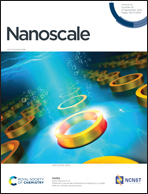Acid-regulated boron–nitrogen codoped multicolor carbonized polymer dots and applications for pH sensing and trace water detection†
Abstract
To obtain multicolor carbonized polymer dots (CPDs), acid-assisted hydrothermal/solvothermal reactions are an effective strategy. However, the long wavelength fluorescence of boron–nitrogen codoped CPDs (BN-CPDs) is rarely reported. In this work, we used concentrated hydrochloric acid to regulate the fluorescence (from green to orange) of BN-CPDs via a solvothermal reaction. Meanwhile, 3-formylphenylboronic acid with a benzene ring structure was employed as the boron source, which helped the formation of the internal conjugated structure of CPDs to obtain long wavelength fluorescent CPDs. The fluorescence properties of BN-CPDs were investigated, which indicated the concentration- and solvent-dependent properties of the BN-CPDs. Based on the experimental results, we assume that the multicolor emission of the BN-CPDs originates from the synergistic effects of the degree of graphitization and surface states. Due to the special fluorescence properties of the BN-CPDs, pH sensing and trace water detection in dichloromethane solution can be effectively achieved. The results of the study reveal the potential of BN-CPDs in sensing applications.



 Please wait while we load your content...
Please wait while we load your content...